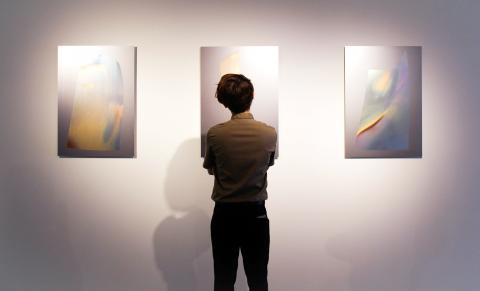After experiencing the Arctic’s midnight sun and polar nights, London-based artist Jessica Rayner found inspiration in the role of light in human life.
“This [experience] made me question what happens when our main source of light — the sun — isn’t available to us?” Rayner said via Skype at the launch of her Faces of Light exhibition at Taipei’s Bluerider Art Gallery on Saturday.
Her first solo exhibition in Asia is an attempt to answer that question.

Photo: Sofia Kuan
Light, darkness and color all work together in her collection to show how they shape the way we perceive ourselves and the world around us. Visitors on Saturday were mainly drawn to the diverse uses of dancing lights and hues in all the pieces, and the strong emotions these convey. Throughout all her works, Rayner uses inanimate objects like orbs, lenses, glass and prisms to capture images that are impossible to see with the naked eye.
The series Awareness of the Light shows Rayner’s ability to draw on the surrounding environment as a means to create art. Visitors to the gallery are welcomed by four aluminum canvases etched with what seems to be a dancing rainbow, but are, in fact, a large plastic Fresnel Lens, a kind of prism, hung in front of a window. She allowed it to dance as the sun’s rays broke through it, capturing a choreography of movement and color.
BEFORE NEWTON
Rayner also brings the viewer back in time with the Before Newton series. These are gray scale glass paintings that are meant to represent how people perceived objects and light before Newton’s discovery of the color spectrum.
The images are more jagged and geometrical in comparison to the rest of the works but they strongly suggest a time when concepts of light were more rigid.
“Everything has a history and story of process and that is something that I’m very interested in with my work,” Rayner said.
In her series Afterimage, Rayner experimented with the change of light throughout the day by photographing square prisms using a Polaroid camera and different filters. The resulting images are colorful yet unclear and off-focus, but purposely so.
Rayner said that her pieces are an attempt to communicate feelings and states of being that are open to interpretation rather than straightforward messages.
At a time when much of the media we consume is over processed and leaves little room for the imagination, it’s refreshing to encounter young artists like Rayner, who employ an abstract yet unpretentious approach.
“Nothing is objective, we are constantly evolving,” Rayner said. “I want [my art] to be more of a mood and an experience and the idea that we are in the midst of a long history. We are here just for a moment in time.”

This month the government ordered a one-year block of Xiaohongshu (小紅書) or Rednote, a Chinese social media platform with more than 3 million users in Taiwan. The government pointed to widespread fraud activity on the platform, along with cybersecurity failures. Officials said that they had reached out to the company and asked it to change. However, they received no response. The pro-China parties, the Chinese Nationalist Party (KMT) and Taiwan People’s Party (TPP), immediately swung into action, denouncing the ban as an attack on free speech. This “free speech” claim was then echoed by the People’s Republic of China (PRC),

Exceptions to the rule are sometimes revealing. For a brief few years, there was an emerging ideological split between the Democratic Progressive Party (DPP) and Chinese Nationalist Party (KMT) that appeared to be pushing the DPP in a direction that would be considered more liberal, and the KMT more conservative. In the previous column, “The KMT-DPP’s bureaucrat-led developmental state” (Dec. 11, page 12), we examined how Taiwan’s democratic system developed, and how both the two main parties largely accepted a similar consensus on how Taiwan should be run domestically and did not split along the left-right lines more familiar in

Most heroes are remembered for the battles they fought. Taiwan’s Black Bat Squadron is remembered for flying into Chinese airspace 838 times between 1953 and 1967, and for the 148 men whose sacrifice bought the intelligence that kept Taiwan secure. Two-thirds of the squadron died carrying out missions most people wouldn’t learn about for another 40 years. The squadron lost 15 aircraft and 148 crew members over those 14 years, making it the deadliest unit in Taiwan’s military history by casualty rate. They flew at night, often at low altitudes, straight into some of the most heavily defended airspace in Asia.

Many people in Taiwan first learned about universal basic income (UBI) — the idea that the government should provide regular, no-strings-attached payments to each citizen — in 2019. While seeking the Democratic nomination for the 2020 US presidential election, Andrew Yang, a politician of Taiwanese descent, said that, if elected, he’d institute a UBI of US$1,000 per month to “get the economic boot off of people’s throats, allowing them to lift their heads up, breathe, and get excited for the future.” His campaign petered out, but the concept of UBI hasn’t gone away. Throughout the industrialized world, there are fears that